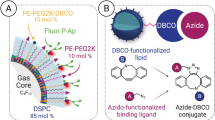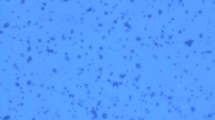Abstract
Purpose
Our objective was to determine the lowest diagnostically effective dose for E-selectin-targeted poly n-butyl cyanoacrylate (PBCA)-shelled microbubbles and to apply it to monitor antiangiogenic therapy effects.
Procedures
PBCA-shelled microbubbles (MBs) coupled to an E-selectin-specific peptide were applied in mice carrying MLS or A431 carcinoma xenografts scaling down the MB dosage to the lowest level where binding could be examined with a 18-MHz small animal ultrasound transducer. Differences in E-selectin expression in the two carcinoma xenografts were confirmed by enzyme-linked immunosorbent assay (ELISA). In addition, MLS tumor-bearing mice under antiangiogenic therapy were monitored using E-selectin-targeted MBs at the lowest applicable dose. Therapy effects on tumor vascularization were verified by immunohistological analyses.
Results
The minimally required dosage was 7 × 107 MBs/kg body weight. This dosage was sufficient to enable E-selectin detection in high E-selectin-expressing MLS tumors, while low E-selectin-expressing A431 tumors required almost 2.5-fold higher doses. At the dose of 7 × 107 MBs/kg body weight, a decrease in E-selectin MB binding under antiangiogenic therapy could be assessed (being significant after 3 days of treatment; p < 0.0001), which was in line with the significant drop in E-selectin-positive area fractions that was found histologically (p < 0.05).
Conclusions
Molecular ultrasound imaging with our E-selectin-targeted MB and therapy monitoring was possible down to a dose of 7 × 107 MBs/kg body weight (equates to 66 μg PBCA/kg and 4.6 mg PBCA/70 kg). Improvements in choice of targets, MB composition, and other MB detection methods may improve sensitivity and lead to reliable detection results of clinically transferrable MBs at even lower dosage levels.






Similar content being viewed by others
References
Klibanov AL (2005) Ligand-carrying gas-filled microbubbles: ultrasound contrast agents for targeted molecular imaging. Bioconjug Chem 16:9–17
Kiessling F, Fokong S, Bzyl J et al (2014) Recent advances in molecular, multimodal and theranostic ultrasound imaging. Adv Drug Deliv Rev 72:15–27
Deshpande N, Needles A, Willmann JK (2010) Molecular ultrasound imaging: current status and future directions. Clin Radiol 65:567–581
Kiessling F, Bzyl J, Fokong S et al (2012) Targeted ultrasound imaging of cancer: an emerging technology on its way to clinics. Curr Pharm Des 18:2184–2199
Kaufmann BA, Sanders JM, Davis C et al (2007) Molecular imaging of inflammation in atherosclerosis with targeted ultrasound detection of vascular cell adhesion molecule-1. Circulation 116:276–284
Villanueva FS, Lu E, Bowry S et al (2007) Myocardial ischemic memory imaging with molecular echocardiography. Circulation 115:345–352
Wu Z, Curaj A, Fokong S et al (2013) Rhodamine-loaded intercellular adhesion molecule-1-targeted microbubbles for dual-modality imaging under controlled shear stresses. Circulation 6:974–981
Wang H, Felt SA, Machtaler S, et al. (2015) Ultrasound imaging of inflammation in a porcine acute terminal ileitis model with a molecularly targeted contrast agent. Radiology
Wang B, Zang WJ, Wang M et al (2006) Prolonging the ultrasound signal enhancement from thrombi using targeted microbubbles based on sulfur-hexafluoride-filled gas. Acad Radiol 13:428–433
Nakatsuka MA, Mattrey RF, Esener SC et al (2012) Aptamer-crosslinked microbubbles: smart contrast agents for thrombin-activated ultrasound imaging. Adv Mater 24:6010–6016
Meyer DL, Schultz J, Lin Y et al (2001) Reduced antibody response to streptavidin through site-directed mutagenesis. Protein Sci 10:491–503
Paganelli G, Chinol M, Maggiolo M et al (1997) The three-step pretargeting approach reduces the human anti-mouse antibody response in patients submitted to radioimmunoscintigraphy and radioimmunotherapy. Eur J Nucl Med 24:350–351
Pochon S, Tardy I, Bussat P et al (2010) BR55: a lipopeptide-based VEGFR2-targeted ultrasound contrast agent for molecular imaging of angiogenesis. Investig Radiol 45:89–95
Kiessling F, Fokong S, Koczera P et al (2012) Ultrasound microbubbles for molecular diagnosis, therapy, and theranostics. J Nucl Med 53:345–348
Anderson CR, Rychak JJ, Backer M et al (2010) scVEGF microbubble ultrasound contrast agents: a novel probe for ultrasound molecular imaging of tumor angiogenesis. Investig Radiol 45:579
John R, Nguyen FT, Kolbeck KJ et al (2012) Targeted multifunctional multimodal protein-shell microspheres as cancer imaging contrast agents. Mol Imaging Biol 14:17–24
Anderson CR, Hu X, Tlaxca J et al (2011) Ultrasound molecular imaging of tumor angiogenesis with an integrin targeted microbubble contrast agent. Investig Radiol 46:215
Fokong S, Fragoso A, Rix A et al (2013) Ultrasound molecular imaging of E-selectin in tumor vessels using poly n-butyl cyanoacrylate microbubbles covalently coupled to a short targeting peptide. Investig Radiol 48:843–850
Biancone L, Araki M, Araki K et al (1996) Redirection of tumor metastasis by expression of E-selectin in vivo. J Exp Med 183:581–587
van Wamel A, Celebi M, Hossack JA et al. (2007) AL 11A-4 molecular imaging with targeted contrast agents and high frequency ultrasound. Proc IEEE Ultrason Symp. 961–64
Fukuda MN, Ohyama C, Lowitz K et al (2000) A peptide mimic of E-selectin ligand inhibits sialyl Lewis X-dependent lung colonization of tumor cells. Cancer Res 60:450–456
Bzyl J, Palmowski M, Rix A et al (2013) The high angiogenic activity in very early breast cancer enables reliable imaging with VEGFR2-targeted microbubbles (BR55). Eur Radiol 23:468–475
Blomley M, Claudon M, Cosgrove D (2007) WFUMB safety symposium on ultrasound contrast agents: clinical applications and safety concerns. Ultrasound Med Biol 33:180–186
Bzyl J, Lederle W, Rix A et al (2011) Molecular and functional ultrasound imaging in differently aggressive breast cancer xenografts using two novel ultrasound contrast agents (BR55 and BR38). Eur Radiol 21:1988–1995
Pysz MA, Foygel K, Rosenberg J et al (2010) Antiangiogenic cancer therapy: monitoring with molecular US and a clinically translatable contrast agent (BR55). Radiology 256:519–527
Bettinger T, Bussat P, Tardy I et al (2012) Ultrasound molecular imaging contrast agent binding to both E- and P-selectin in different species. Investig Radiol 47:516–523
Kaufmann BA, Lewis C, Xie A et al (2007) Detection of recent myocardial ischaemia by molecular imaging of P-selectin with targeted contrast echocardiography. Eur Heart J 28:2011–2017
Wang H, Machtaler S, Bettinger T et al (2013) Molecular imaging of inflammation in inflammatory bowel disease with a clinically translatable dual-selectin-targeted US contrast agent: comparison with FDG PET/CT in a mouse model. Radiology 267:818–829
Rix A, Lederle W, Siepmann M et al (2012) Evaluation of high frequency ultrasound methods and contrast agents for characterising tumor response to anti-angiogenic treatment. Eur J Radiol 81:2710–2716
Klibanov AL (2007) Ultrasound molecular imaging with targeted microbubble contrast agents. J Nucl Cardiol 14:876–884
Moghimi SM, Hamad I (2008) Liposome-mediated triggering of complement cascade. J Liposome Res 18:195–209
Chonn AP, Cullis PR, Devine DV (1991) The role of surface charge in the activation of the classical and alternative pathways of complement by liposomes. J Immunol 146:4234–4241
Moore KL, Eaton SF, Lyons DE et al (1994) The P-selectin glycoprotein ligand from human neutrophils displays sialylated, fucosylated, O-linked poly-N-acetyllactosamine. J Biol Chem 269:23318–23327
Luboldt W, Zöphel K, Wunderlich G et al (2010) Visualization of somatostatin receptors in prostate cancer and its bone metastases with Ga-68–DOTATOC PET/CT. Mol Imaging Biol 12:78–84
Kiessling F, Huppert J, Palmowski M (2009) Functional and molecular ultrasound imaging: concepts and contrast agents. Curr Med Chem 16:627–642
Willmann JRK, Cheng Z, Davis C et al (2008) Targeted microbubbles for imaging tumor angiogenesis: assessment of whole-body biodistribution with dynamic micro-PET in mice 1. Radiology 249:212–219
Rychak JJ, Klibanov AL, Ley KF, Hossack JA (2007) Enhanced targeting of ultrasound contrast agents using acoustic radiation force. Ultrasound Med Biol 33:1132–1139
Gessner RC, Streeter JE, Kothadia R et al (2012) An in vivo validation of the application of acoustic radiation force to enhance the diagnostic utility of molecular imaging using 3-D ultrasound. Ultrasound Med Biol 38:651–660
Frinking PJ, Tardy I, Théraulaz M et al (2012) Effects of acoustic radiation force on the binding efficiency of BR55, a VEGFR2-specific ultrasound contrast agent. Ultrasound Med Biol 38:1460–1469
Ackermann D, Schmitz G (2013) Reconstruction of flow velocity inside vessels by tracking single microbubbles with an MCMC data association algorithm. Proc IEEE Ultrason Symp 627–630
Acknowledgments
This work was supported by the German Research Foundation (DFG), grant numbers KI 1072/5-1, KI1072/11-1, and SCHM1171/3-1, the DAAD project PHC Procope 31017PH, “Development of multimodal imaging probes for intravascular molecular imaging of tumors and inflammation,” and the Portuguese Fundação para a Ciência e a Tecnologia (FCT), grant number PTDC/QEQ-MED/2656/2012.
Conflict of Interest
The authors declare that they have no competing interests.
Author information
Authors and Affiliations
Corresponding author
Electronic Supplementary Material
Below is the link to the electronic supplementary material.
Supplementary Fig. 1
Images showing single PBCA MBs in a gelatin matrix. B-mode (a) and contrast-mode-specific (b) ultrasound images were recorded shortly before (pre) and after (post) a destructive pulse (ultrasound imaging protocol correspondent to the experimental setup mentioned in the “Material and Methods” section). Through dilution of the MB suspension up to 2,750 MBs/ml, the calculated average amount of MBs in the ultrasound section was 6.25. The B-mode image shows signal from six similar particles before the destructive pulse, while the captured image after the pulse shows sole background signal. Hence, it is very likely that the Vevo 2100 with 18 MHz can detect single PBCA MBs in B-mode, while imaging with amplitude modulation showed no signal from MBs in the matrix at this level of dilution (PDF 821 kb)
Rights and permissions
About this article
Cite this article
Spivak, I., Rix, A., Schmitz, G. et al. Low-Dose Molecular Ultrasound Imaging with E-Selectin-Targeted PBCA Microbubbles. Mol Imaging Biol 18, 180–190 (2016). https://doi.org/10.1007/s11307-015-0894-9
Published:
Issue Date:
DOI: https://doi.org/10.1007/s11307-015-0894-9




